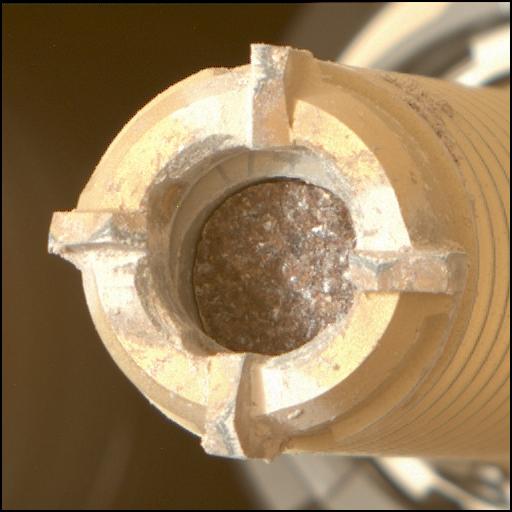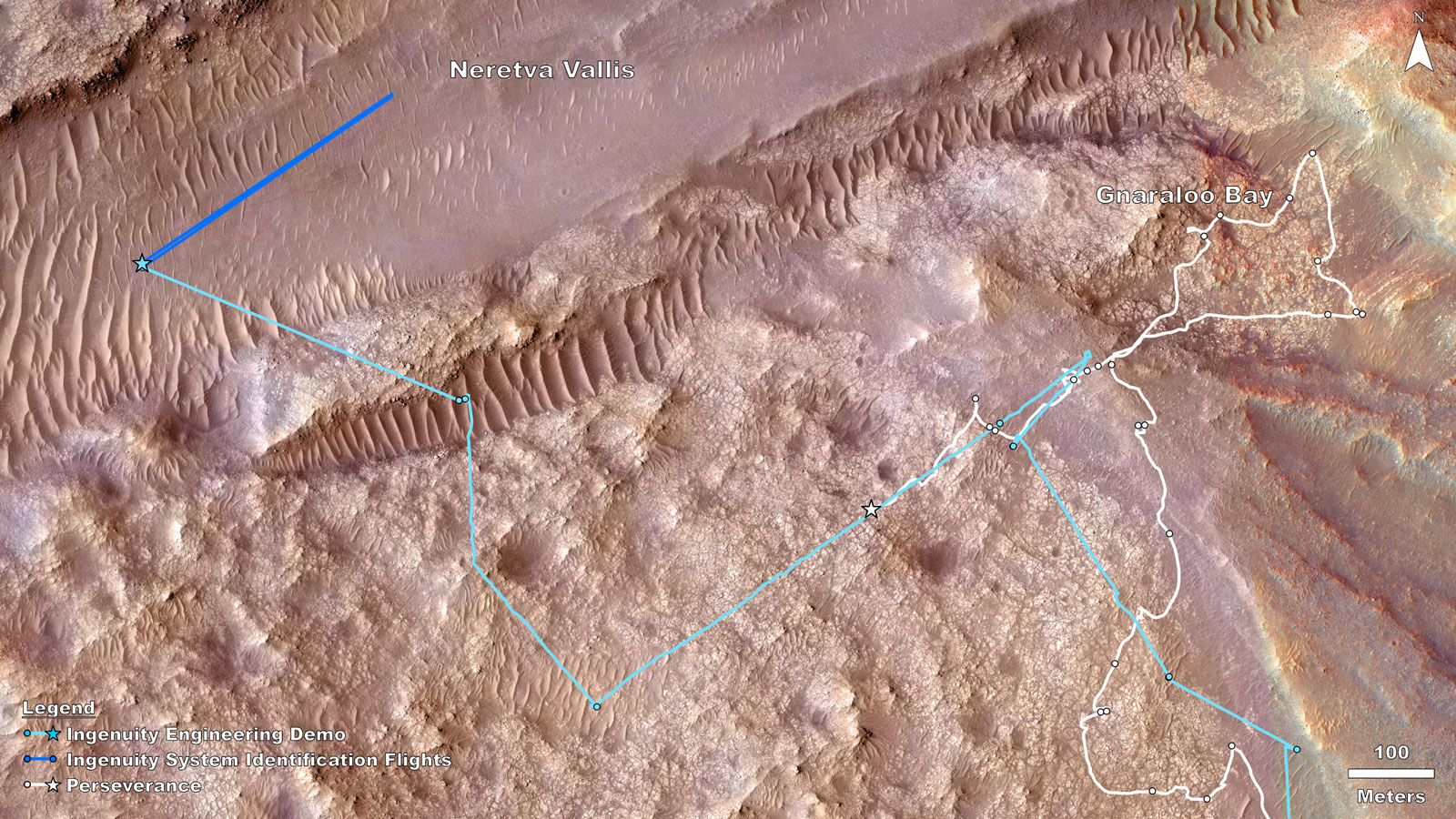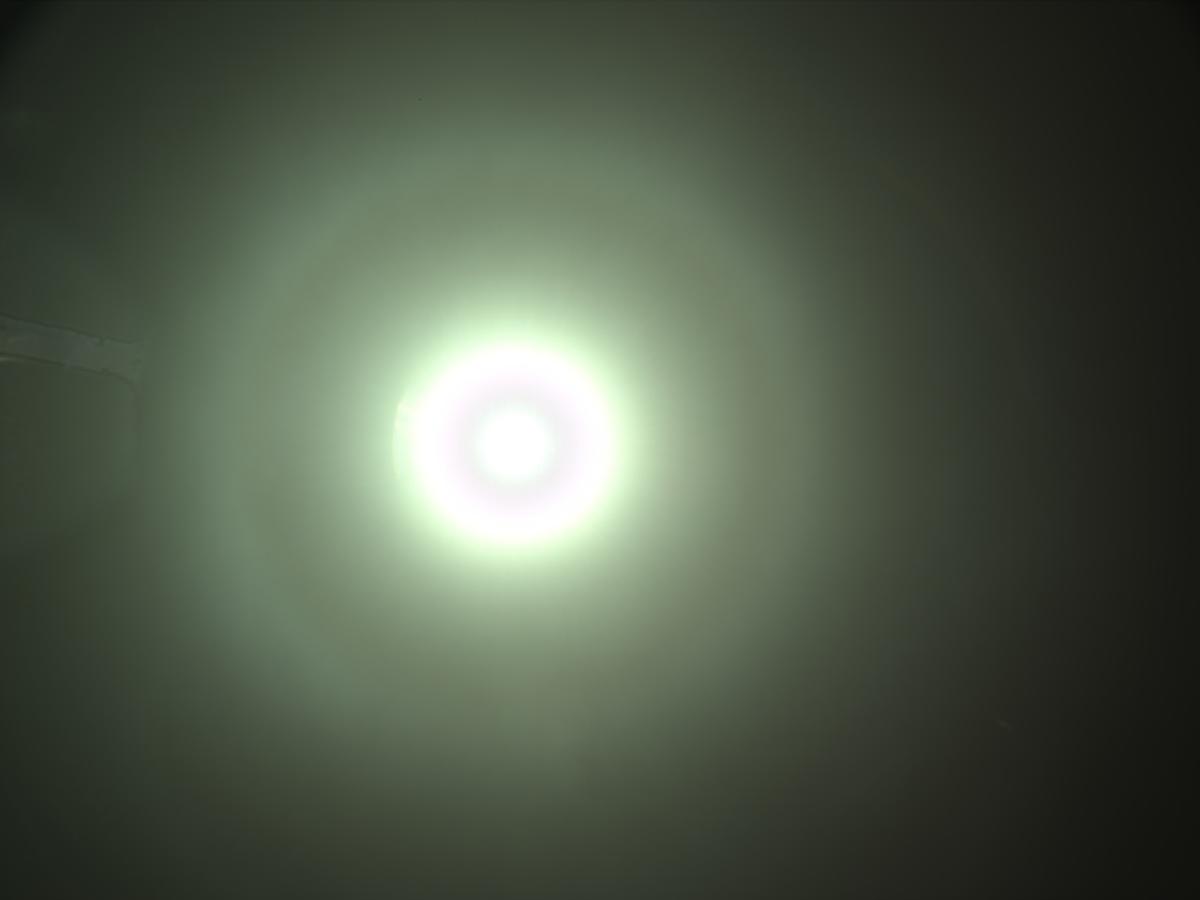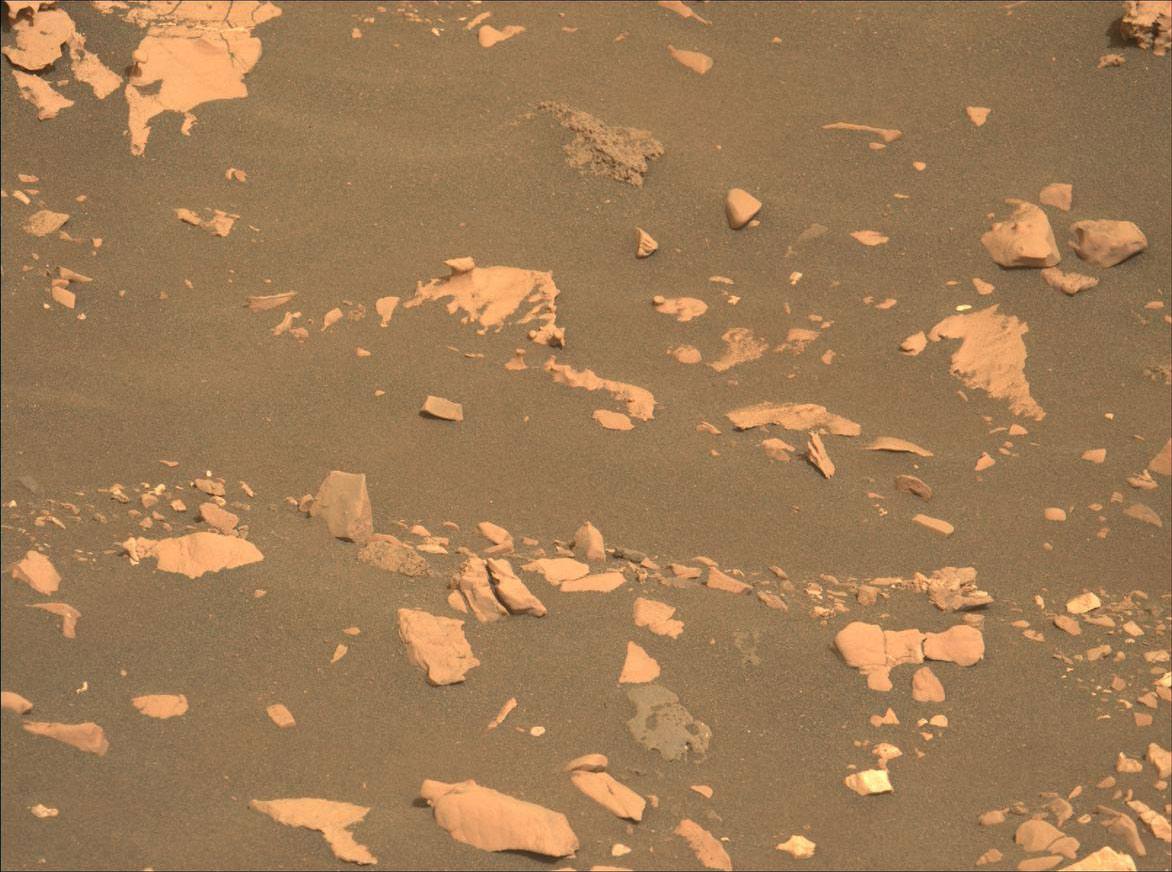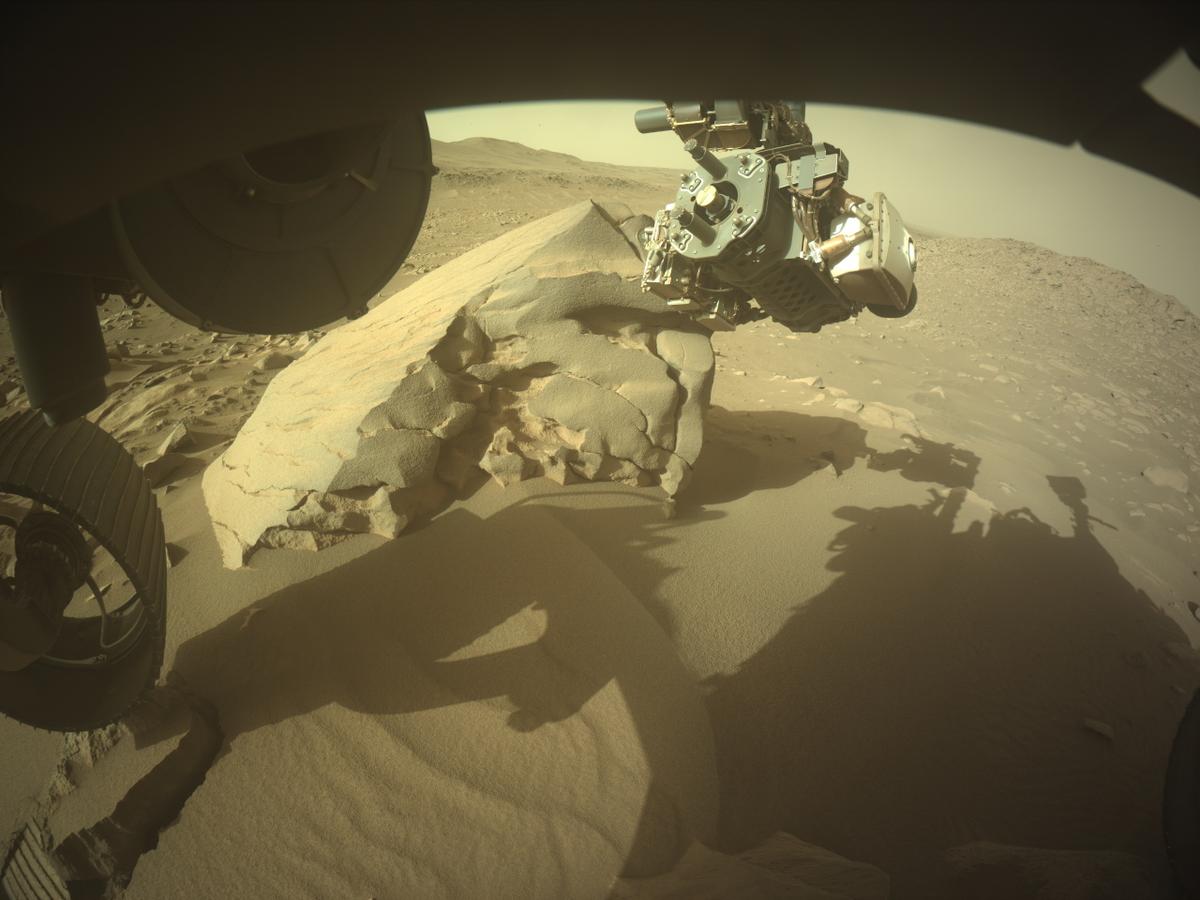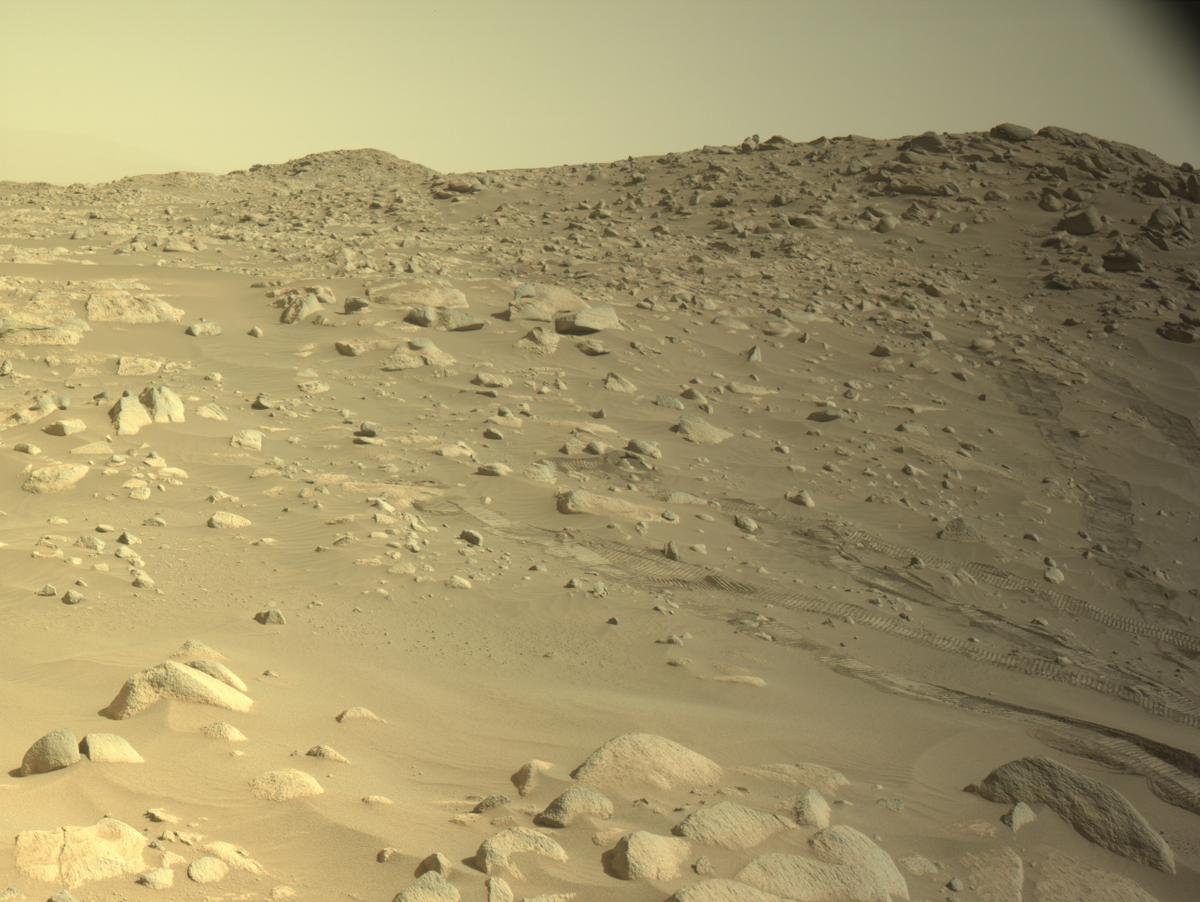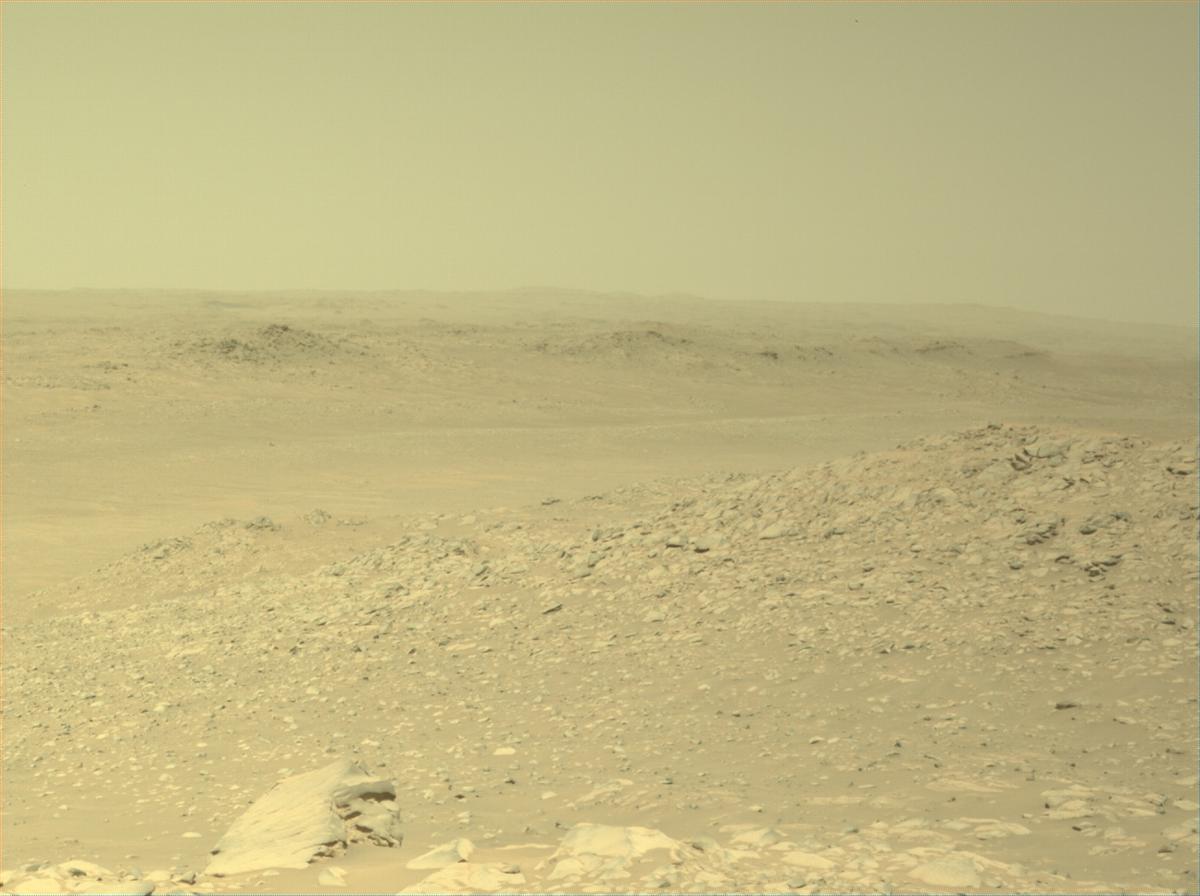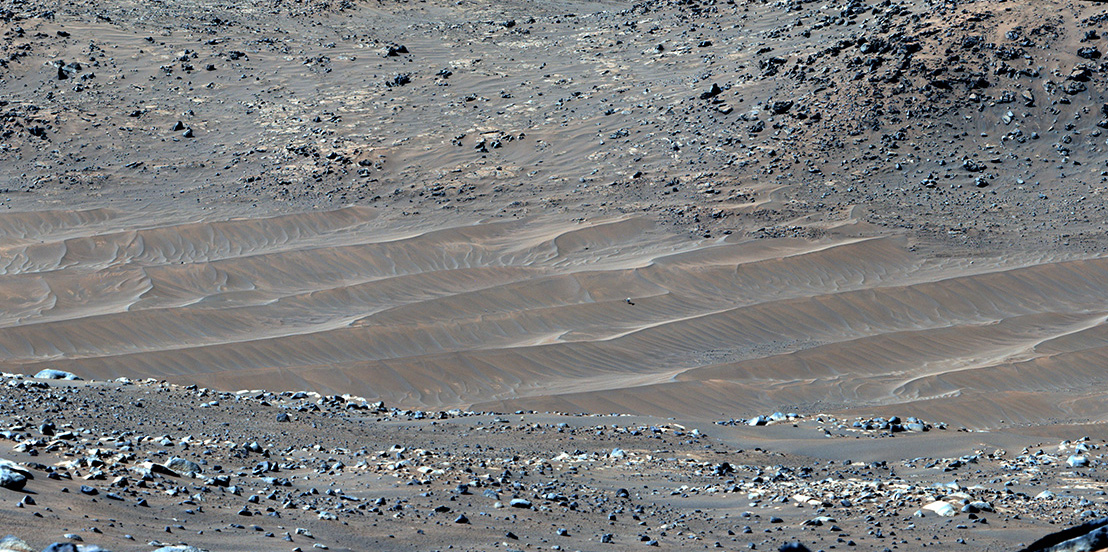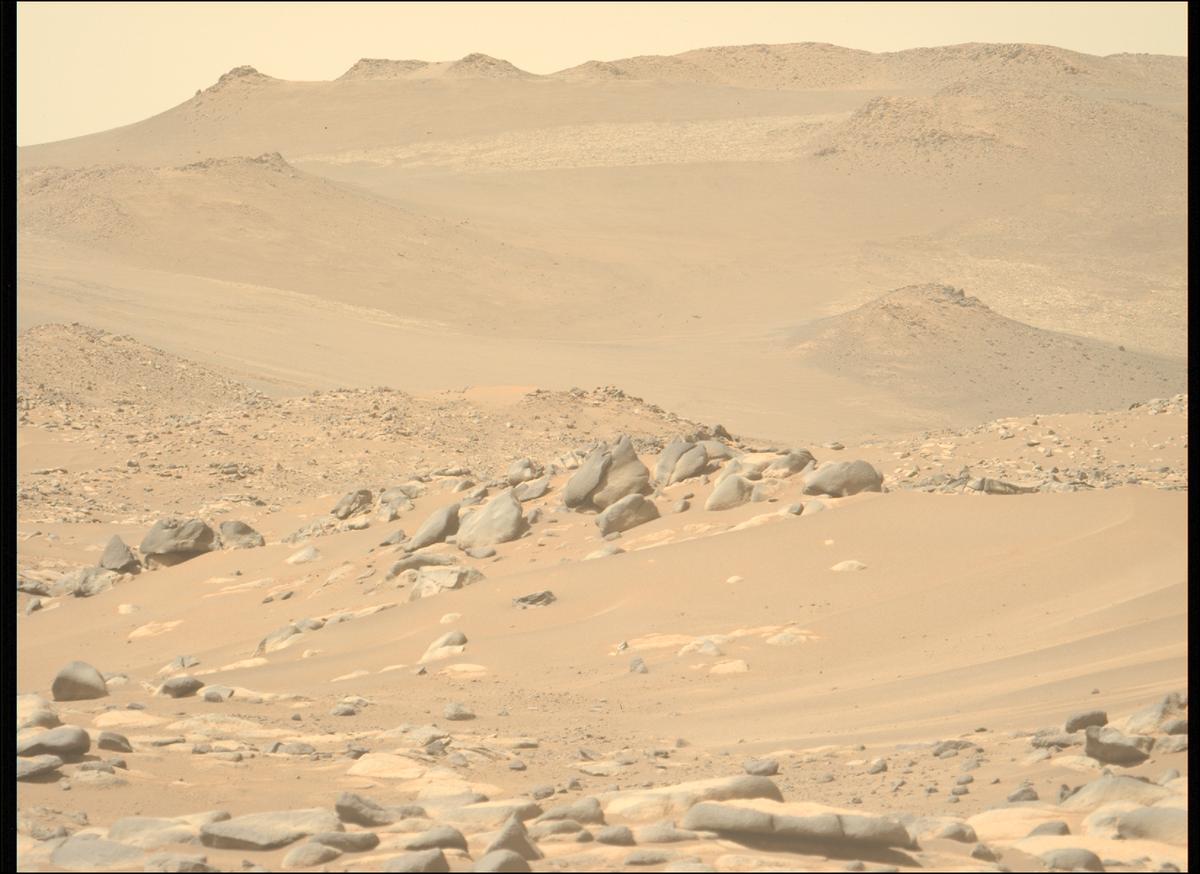After investigating the high-standing bedrock at the Bunsen Peak workspace deep within the Margin Unit, the unique nature and composition of this rock was deemed worthy for collection of Perseverance’s 24th rock core sample, Comet Geyser!
Bunsen Peak is named after a prominent peak in Yellowstone National, Park, Wyoming, USA, and the namesake for Comet Geyser is the silica-sintered cone geys...
April 16, 2024
Comet Geyser: Perseverance's 24th Rock Core
Comet Geyser: Perseverance's 24th Rock Core
Mars Perseverance Sol 1088 - Right Mastcam-Z Camera: Mastcam-Z image of the Comet Geyser core. The partially illuminated core is visible in this image of Perseverance’s coring bit. The diameter of the core is 1.3 cm. NASA's Mars Perseverance rover acquired this image using its Right Mastcam-Z camera. Mastcam-Z is a pair of cameras located high on the rover's mast. This image was acquired on March 12, 2024 (Sol 1088) at the local mean solar time of 15:31:51.
Credits: NASA/JPL-Caltech/ASU.
Download image ›
March 29, 2024
Unlocking the Martian Skies – Using Ingenuity as a Martian Testbed for Future Rotorcraft
Unlocking the Martian Skies – Using Ingenuity as a Martian Testbed for Future Rotorcraft
Rover, Helicopter Locations in Jezero Crater: Helicopter and rover locations on Sol 1007. Ingenuity conducted Flights 68 and 69 in the lower flat section of Neretva Vallis while the rover conducted science operations in Gnaraloo Bay and started its westward traverse to the crater rim.
Credits: NASA/JPL-Caltech.
Download image ›
Nowhere on Earth can we fully replicate the conditions on Mars. Special facilities can re-create certain elements with enough fidelity to test specific scenarios, but each is limited, leading to a plethora of platforms and scenarios required to span the conditions of Mars. In our prior post, “The Right Stuff,” the focus was using Ingenuity on Mars to test our macro capabilities: flying higher a...
March 18, 2024
Perseverance Pays off When Studying the Martian Atmosphere
Perseverance Pays off When Studying the Martian Atmosphere
Mars Perseverance Sol 965 - Left Navigation Camera: A halo imaged on sol 965, in the final image taken by Perseverance’s Navigation cameras before conjunction and the end of the cloudy season.
Credits: NASA/JPL-Caltech.
Download image ›
Studying the atmosphere with Perseverance can be challenging! Imagine spotting an interesting cloud in a photo taken yesterday; unlike something interesting on the surface, more observations just aren’t possible, as it’s long gone by now. Or imagine trying to take a movie of a dust devil zooming across Jezero crater, when the rover’s daily activities are all planned out before the rover even wa...
March 11, 2024
Throwback to the Little 'Mushroom'
Throwback to the Little 'Mushroom'
Mars Perseverance Sol 467 - Left Mastcam-Z Camera: This image of a mushroom-shaped rock feature (top left) was acquired on June 13, 2022 (Sol 467) at the local mean solar time of 13:00:39 using the Mastcam-Z instrument.
Credits: NASA/JPL-Caltech/ASU.
Download image ›
Back in 2022, Perseverance found my favourite rock on the mission so far: a flat piece with a mushroom-shaped rock feature sticking out of it! The “mushroom” is about 1-2 cm tall and less than 1 cm wide. The rock was in an area the rover explored called Hogwallow Flats. Many aspects of Hogwallow Flats set it apart from the rest of the rocks in Jezero: it was very fine-grained compared to other ...
February 29, 2024
Bunsen Peak Piques Interest
Bunsen Peak Piques Interest
Mars Perseverance Sol 1071 – Front Left Hazard Avoidance Camera: Image of science in progress on the Bunsen Peak workspace in front of the rover. This image was acquired on Feb. 24, 2024 (Sol 1071) at the local mean solar time of 14:48:14.
Credits: NASA/JPL-Caltech.
Download image ›
Perseverance has continued its traverse west through the Margin unit. As the rover drives, images and data are obtained using instruments such as Mastcam-Z, Navcam, and SuperCam to track any changes in the chemistry or appearance of the rocks.
Along the way, the science team used these images to pick out an exciting rock named Bunsen Peak. This rock was intriguing because it stands tall amon...
February 22, 2024
Depositional Processes of the Margin Unit
Depositional Processes of the Margin Unit
Mars Perseverance Sol 1066 - Left Navigation Camera: An image of the martian geology on the way to Beheive Geyser. NASA's Mars Perseverance rover acquired this image using its onboard Left Navigation Camera (Navcam). The camera is located high on the rover's mast and aids in driving. This image was acquired on Feb. 19, 2024 (Sol 1066) at the local mean solar time of 12:47:59.
Credits: NASA/JPL-Caltech.
Download image ›
There has been much discussion and interest regarding the origin of the Margin unit. The Margin unit has gained interest due to the presence of carbonates and its implications for the paleoenvironment and biosignature preservation of ancient Mars. There are several possible origins for the Margin unit, and further analysis of these rocks will shed light on what environment the Margin unit forme...
February 14, 2024
Beehive Geyser Beckons
Beehive Geyser Beckons
Mars Perseverance Sol 1059 - Left Navigation Camera: Perseverance captured this view of the landscape to its north on Feb. 11, 2024. In the bottom-left you can see “Bunsen Peak”, a rock we plan to study up-close later this week.
Credits: NASA/JPL-Caltech.
Download image ›
Perseverance continues its uphill march through the tricky terrain of the margin unit, an area with enhanced signals of carbonate. We are headed toward a region we’ve nicknamed “Beehive Geyser,” an area about 500 m to the west. What draws us here? Well, this region lies approximately 60 m above the part of the margin unit that we encountered and sampled for the first time last September. By com...
February 08, 2024
Farewell to Our Flying Friend and Closing in on the Crater Rim
Farewell to Our Flying Friend and Closing in on the Crater Rim
Perseverance Spots Ingenuity at Its Final Airfield: NASA’s Perseverance Mars rover captured this mosaic showing the Ingenuity Mars Helicopter at its final airfield on Feb. 4, 2024. The helicopter damaged its rotor blades during landing on its 72nd flight on Jan. 18, 2024. The Ingenuity team has nicknamed the spot where the helicopter completed its final flight “Valinor Hills” after the fictional location in J.R.R. Tolkien’s fantasy novels, which include “The Lord of the Rings” trilogy.
Credits: NASA/JPL-Caltech/ASU/MSSS.
Download image ›
After 72 flights and 17 kilometers flown, it is finally time for us to say goodbye to the Ingenuity helicopter. It was announced last week that Ingenuity’s mission is now coming to an end after it sustained damage to a rotor blade on its final flight. Ingenuity’s long and remarkably successful journey began three years ago on the floor of Jezero Crater and it will end in Neretva Vallis, a chann...
February 01, 2024
Bright Rocks on the Horizon: An Exciting Glimpse of Uncharted Territory
Bright Rocks on the Horizon: An Exciting Glimpse of Uncharted Territory
Mars Perseverance Sol 1039 - Left Mastcam-Z Camera: Mastcam-Z image (Sol 1039, zcam03849) showing bright, light-toned outcrops near the Jezero Crater Rim (upper center) approximately 4 km away, with darker toned boulders in foreground (center).
Credits: NASA/JPL-Caltech/ASU.
Download image ›
Perseverance is deep within the ongoing Margin Unit campaign, where orbital signatures of carbonate minerals appear strongest. After collection of a drilled rock core from the Margin Unit, followed by 20 Sols (Martian days) parked at our current workspace, Perseverance had ample time to explore the rocks adjacent to the rover and perform long distance multispectral imaging of the Jezero Crater ...
January 25, 2024
New Year, New Images from Mars!
New Year, New Images from Mars!
Mars Perseverance Sol 1029 - Left Mastcam-Z Camera: This image of the Minga natural surface proximity science target was acquired on January 11, 2024 (Sol 1029) at the local mean solar time of 11:48:35 using the Mastcam-Z instrument.
Credits: NASA/JPL-Caltech/ASU.
Download image ›
Since parking at Airey Hill during Solar Conjunction back in November, Perseverance has been busy exploring. We drove north from Airey Hill to Flat Point, where we had the best views to conduct imaging using Mastcam-Z of some of the deepest parts of the Margin Unit. We then drove south-east, parallel to a ridge that shows apparent layering, and imaged targets including Burnt Island and Lily Bay...
About This Blog
These blog updates are provided by the teams working on Mars missions.
Dates of planned test activities are subject to change due to a variety of factors related to the Martian environment, communication relays, orbiter, helicopter and/or rover status.
Sign up to Mars Newsletter
Contributors+
-
Deputy Program Scientist, NASA HQ -
Systems Engineer, NASA/JPL -
Student Collaborator on PIXL, University of Washington -
Ph.D. Student, University of the Basque Country -
Ph.D. Student, Purdue University -
Sampling Operations Deputy Lead, NASA/JPL -
Student Collaborator on Mastcam-Z, Western Washington University -
Ingenuity Operations Engineer, NASA/JPL -
Chief Engineer for the Mars Helicopter Project, NASA/JPL -
Student Collaborator, Purdue University -
Atmospheric Scientist, Aeolis Research -
Media Representative, NASA/JPL -
Co-Investigator, PIXL Instrument, Technical University of Denmark (DTU) -
Student Collaborator, University of Florida -
Ph.D. Student, Rice University -
Student Collaborator, University of Hawaiʻi at Mānoa -
Ph.D. Student, University of California, Los Angeles -
Student Collaborator, McGill University -
MOXIE Science Team Member, Lunar Outpost -
Mapping Specialist, NASA/JPL -
Ingenuity Mars Helicopter Chief Pilot, NASA/JPL -
Sampling Engineer, NASA/JPL -
Ingenuity Chief Engineer, NASA/JPL -
Project Manager, NASA/JPL -
Ingenuity Mars Helicopter Mechanical Engineering Lead, NASA/JPL -
Ingenuity Mars Helicopter Operations Lead, NASA/JPL -
Imaging Scientist and Mastcam-Z Deputy Principal Investigator, NASA/JPL -
Deputy Project Scientist, NASA/JPL -
Project Scientist, Caltech -
Chief Engineer for Sampling & Caching, NASA/JPL -
Student Collaborator, University of Florida -
Planetary Scientist, Smithsonian National Air & Space Museum -
Ingenuity Pilot, NASA/JPL -
Vehicle Systems Engineer, NASA/JPL -
SuperCam/ChemCam Engineer, Los Alamos National Laboratory -
Mars Oxygen In-Situ Resource Utilization Experiment (MOXIE) Principal Investigator, Massachusetts Institute of Technology -
Ingenuity Mars Helicopter Project Manager, NASA/JPL -
Vehicle Systems Engineer Lead, NASA/JPL -
Mars 2020 Student Collaborator, University of Florida -
Systems Engineer, NASA/JPL -
Deputy Project Manager, NASA/JPL -
Principal Investigator, SuperCam / Co-Investigator, SHERLOC instrument, Purdue University -
Assistant Science Manager, NASA/JPL -
Docking Systems Engineer, NASA/JPL -
SuperCam, PhD Student, Purdue University -
Perseverance Deputy Project Manager, NASA/JPL -
Ingenuity Team Lead, NASA/JPL -
Robotic Systems Engineer, NASA/JPL -
Chief Engineer Ingenuity Mars Helicopter, NASA/JPL -
Chief Engineer for Robotic Operations, NASA/JPL -
Science Operations Systems Engineer, Staff Scientist, NASA/JPL


